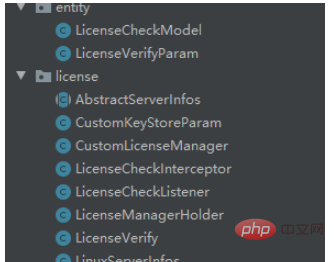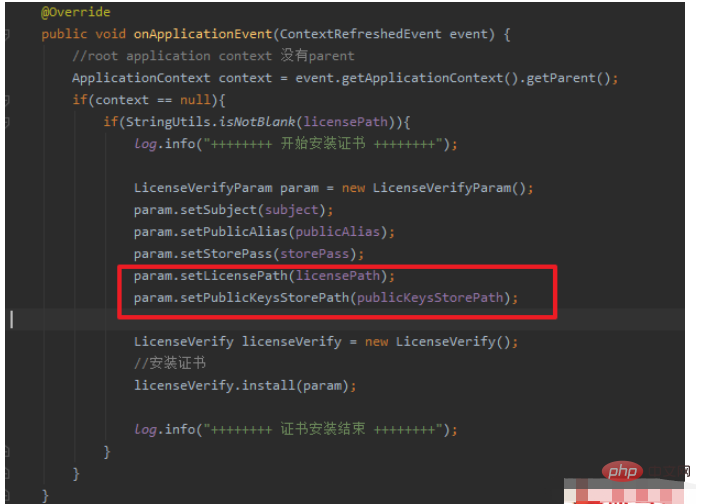How to understand how SpringBoot generates a License
Preface
License refers to the copyright license. After we develop the system, if we don’t want users to use it for free all the time, for example, renewing based on time, the License will be useful.
We can specify the validity period of the License for the system and control the available time of the system.
So for the SpringBoot project, how to increase the License? Next, the prince will bring you a set of solutions. (Of course there is more than one way to implement it)
Generate License
The tool has been packaged, and friends can download and use it directly: https://gitee.com/lm970585581/spring-boot2-license
After downloading, open the cloud-license-serve project and start it directly.
Then call the project’s information acquisition interface: http://localhost:9081/license/getServerInfos?osName=windows
You will get results similar to the following, representing ip address, mac address, and cpu respectively. Serial number, motherboard serial number.
{
"ipAddress": [
"192.168.80.1",
"192.168.220.1"
],
"macAddress": [
"01-51-56-C0-00-01",
"00-52-56-C0-00-08",
"BC-54-2D-DF-69-FC"
],
"cpuSerial": "BFECFBFF000806EC",
"mainBoardSerial": "L1HF16301D5"
}Use the keytool tool that comes with JDK to generate the public and private key certificate store:
If we set the public key store password to: public_password1234 and the private key store password to: private_password1234, the generated command is as follows:
#生成命令 keytool -genkeypair -keysize 1024 -validity 3650 -alias "privateKey" -keystore "privateKeys.keystore" -storepass "public_password1234" -keypass "private_password1234" -dname "CN=localhost, OU=localhost, O=localhost, L=SH, ST=SH, C=CN" #导出命令 keytool -exportcert -alias "privateKey" -keystore "privateKeys.keystore" -storepass "public_password1234" -file "certfile.cer" #导入命令 keytool -import -alias "publicCert" -file "certfile.cer" -keystore "publicCerts.keystore" -storepass "public_password1234"
After the above command is executed, three files will be generated in the current path, namely: privateKeys.keystore, publicCerts.keystore, and certfile.cer. The file certfile.cer is no longer needed and can be deleted. The file privateKeys.keystore is used in the current ServerDemo project to generate license files for customers, while the file publicCerts.keystore is deployed to the customer server along with the application code. The user decrypts the license file and verifies its license. information.
Finally, we generate the license, and the calling interface address is: http://localhost:9081/license/generateLicense
The calling parameter is a json parameter with the following format:
{
"subject": "license_demo",
"privateAlias": "privateKey",
"keyPass": "private_password1234",
"storePass": "public_password1234",
"licensePath": "C:/Users/zifangsky/Desktop/license_demo/license.lic",
"privateKeysStorePath": "C:/Users/zifangsky/Desktop/license_demo/privateKeys.keystore",
"issuedTime": "2018-07-10 00:00:01",
"expiryTime": "2019-12-31 23:59:59",
"consumerType": "User",
"consumerAmount": 1,
"description": "这是证书描述信息",
"licenseCheckModel": {
"ipAddress": ["192.168.245.1", "10.0.5.22"],
"macAddress": ["00-50-56-C0-00-01", "50-7B-9D-F9-18-41"],
"cpuSerial": "BFEBFBFF000406E3",
"mainBoardSerial": "L1HF65E00X9"
}
}If the request is successful, a license.lic file will be generated at the path set by the licensePath parameter. This file is the server license file for deploying code to customers.
Using License
If you follow the above steps step by step, we have obtained the license.lic, and the next step is to use the license in our own projects .
cloud-license-client is an example of an imported project. You can open it and use it directly.
To introduce your own project, just import the following files into

# and configure the interceptor LicenseCheckInterceptor to use it. The configuration method is in the InterceptorConfig class, you can refer to it.
It should be noted here that using license requires two files: license.lic, publicCerts.keystore
The path configured in the demo project is an absolute path. Generally, we will configure a relative path and put the two Put the file under the project, and the configuration location is in the LicenseCheckListener class.
Just modify the following part to read it from a relative path.

I will not demonstrate how to do it here. Modified because it is easy to modify.
One more thing to note:
For the LicenseCheckModel and LicenseCreatorParam classes, after introducing them to your own client, you must ensure that the package name is consistent with the package name when generating the license, otherwise it will cause a sequence The problem of transformation failure.
The above is the detailed content of How to understand how SpringBoot generates a License. For more information, please follow other related articles on the PHP Chinese website!

Hot AI Tools

Undresser.AI Undress
AI-powered app for creating realistic nude photos

AI Clothes Remover
Online AI tool for removing clothes from photos.

Undress AI Tool
Undress images for free

Clothoff.io
AI clothes remover

Video Face Swap
Swap faces in any video effortlessly with our completely free AI face swap tool!

Hot Article

Hot Tools

Notepad++7.3.1
Easy-to-use and free code editor

SublimeText3 Chinese version
Chinese version, very easy to use

Zend Studio 13.0.1
Powerful PHP integrated development environment

Dreamweaver CS6
Visual web development tools

SublimeText3 Mac version
God-level code editing software (SublimeText3)

Hot Topics
 1386
1386
 52
52
 How Springboot integrates Jasypt to implement configuration file encryption
Jun 01, 2023 am 08:55 AM
How Springboot integrates Jasypt to implement configuration file encryption
Jun 01, 2023 am 08:55 AM
Introduction to Jasypt Jasypt is a java library that allows a developer to add basic encryption functionality to his/her project with minimal effort and does not require a deep understanding of how encryption works. High security for one-way and two-way encryption. , standards-based encryption technology. Encrypt passwords, text, numbers, binaries... Suitable for integration into Spring-based applications, open API, for use with any JCE provider... Add the following dependency: com.github.ulisesbocchiojasypt-spring-boot-starter2. 1.1Jasypt benefits protect our system security. Even if the code is leaked, the data source can be guaranteed.
 How SpringBoot integrates Redisson to implement delay queue
May 30, 2023 pm 02:40 PM
How SpringBoot integrates Redisson to implement delay queue
May 30, 2023 pm 02:40 PM
Usage scenario 1. The order was placed successfully but the payment was not made within 30 minutes. The payment timed out and the order was automatically canceled. 2. The order was signed and no evaluation was conducted for 7 days after signing. If the order times out and is not evaluated, the system defaults to a positive rating. 3. The order is placed successfully. If the merchant does not receive the order for 5 minutes, the order is cancelled. 4. The delivery times out, and push SMS reminder... For scenarios with long delays and low real-time performance, we can Use task scheduling to perform regular polling processing. For example: xxl-job Today we will pick
 How to use Redis to implement distributed locks in SpringBoot
Jun 03, 2023 am 08:16 AM
How to use Redis to implement distributed locks in SpringBoot
Jun 03, 2023 am 08:16 AM
1. Redis implements distributed lock principle and why distributed locks are needed. Before talking about distributed locks, it is necessary to explain why distributed locks are needed. The opposite of distributed locks is stand-alone locks. When we write multi-threaded programs, we avoid data problems caused by operating a shared variable at the same time. We usually use a lock to mutually exclude the shared variables to ensure the correctness of the shared variables. Its scope of use is in the same process. If there are multiple processes that need to operate a shared resource at the same time, how can they be mutually exclusive? Today's business applications are usually microservice architecture, which also means that one application will deploy multiple processes. If multiple processes need to modify the same row of records in MySQL, in order to avoid dirty data caused by out-of-order operations, distribution needs to be introduced at this time. The style is locked. Want to achieve points
 How to solve the problem that springboot cannot access the file after reading it into a jar package
Jun 03, 2023 pm 04:38 PM
How to solve the problem that springboot cannot access the file after reading it into a jar package
Jun 03, 2023 pm 04:38 PM
Springboot reads the file, but cannot access the latest development after packaging it into a jar package. There is a situation where springboot cannot read the file after packaging it into a jar package. The reason is that after packaging, the virtual path of the file is invalid and can only be accessed through the stream. Read. The file is under resources publicvoidtest(){Listnames=newArrayList();InputStreamReaderread=null;try{ClassPathResourceresource=newClassPathResource("name.txt");Input
 Comparison and difference analysis between SpringBoot and SpringMVC
Dec 29, 2023 am 11:02 AM
Comparison and difference analysis between SpringBoot and SpringMVC
Dec 29, 2023 am 11:02 AM
SpringBoot and SpringMVC are both commonly used frameworks in Java development, but there are some obvious differences between them. This article will explore the features and uses of these two frameworks and compare their differences. First, let's learn about SpringBoot. SpringBoot was developed by the Pivotal team to simplify the creation and deployment of applications based on the Spring framework. It provides a fast, lightweight way to build stand-alone, executable
 How to implement Springboot+Mybatis-plus without using SQL statements to add multiple tables
Jun 02, 2023 am 11:07 AM
How to implement Springboot+Mybatis-plus without using SQL statements to add multiple tables
Jun 02, 2023 am 11:07 AM
When Springboot+Mybatis-plus does not use SQL statements to perform multi-table adding operations, the problems I encountered are decomposed by simulating thinking in the test environment: Create a BrandDTO object with parameters to simulate passing parameters to the background. We all know that it is extremely difficult to perform multi-table operations in Mybatis-plus. If you do not use tools such as Mybatis-plus-join, you can only configure the corresponding Mapper.xml file and configure The smelly and long ResultMap, and then write the corresponding sql statement. Although this method seems cumbersome, it is highly flexible and allows us to
 How SpringBoot customizes Redis to implement cache serialization
Jun 03, 2023 am 11:32 AM
How SpringBoot customizes Redis to implement cache serialization
Jun 03, 2023 am 11:32 AM
1. Customize RedisTemplate1.1, RedisAPI default serialization mechanism. The API-based Redis cache implementation uses the RedisTemplate template for data caching operations. Here, open the RedisTemplate class and view the source code information of the class. publicclassRedisTemplateextendsRedisAccessorimplementsRedisOperations, BeanClassLoaderAware{//Declare key, Various serialization methods of value, the initial value is empty @NullableprivateRedisSe
 How to get the value in application.yml in springboot
Jun 03, 2023 pm 06:43 PM
How to get the value in application.yml in springboot
Jun 03, 2023 pm 06:43 PM
In projects, some configuration information is often needed. This information may have different configurations in the test environment and the production environment, and may need to be modified later based on actual business conditions. We cannot hard-code these configurations in the code. It is best to write them in the configuration file. For example, you can write this information in the application.yml file. So, how to get or use this address in the code? There are 2 methods. Method 1: We can get the value corresponding to the key in the configuration file (application.yml) through the ${key} annotated with @Value. This method is suitable for situations where there are relatively few microservices. Method 2: In actual projects, When business is complicated, logic




